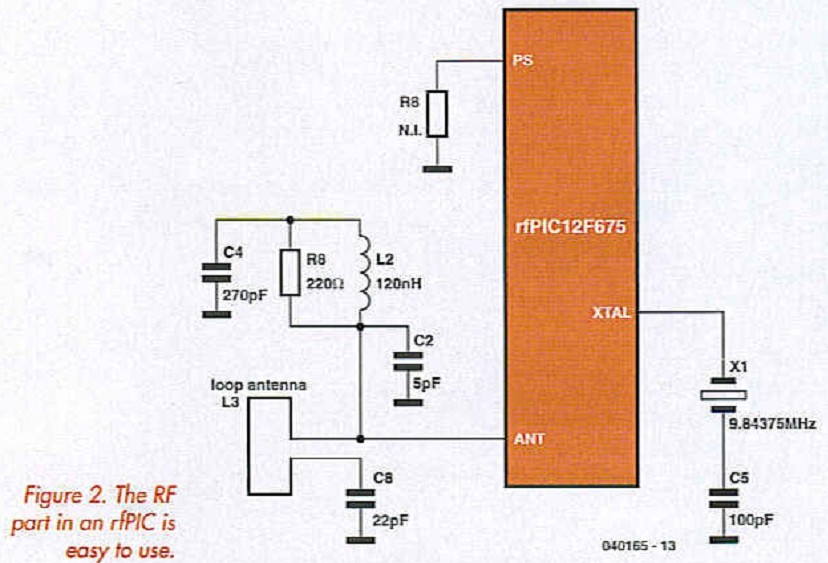

Project Solutions
Trends in Microcontroller (2)
Published:2011/7/31 21:00:00 Author:Phyllis From:SeekIC
By Christian Tavernier
The rfPIC or ’radio’ PIC
In the area of ’small’ microcontrollers it is Microchip who steals the show.
Now that microcontrollers are becoming more common in remote controls, Microchip has decided to offer the rfPIC, literally the radio frequency PIC. This one is part of the small PIC-family that we discussed just before. In a single package, the rfPIC contains, in addition to the microcontroller, a complete circuit for an ASK- or FSK-transmitter (Amplitude or Frequency Shift Keying). Also provided, to ensure a stable frequency, a VCO (Voltage Controlled Oscillator) and a PLL (Phase Locked Loop), based on the crystal frequency of the circuit. The basic version, the rfl2C509 comprises a 12C509 and a built-in transmitter. But for the creative among us the rfl2F675 is much more interesting. This is, after all, the aforementioned 12F675 with the radio added. Applying these controllers is very simple, as is illustrated by Figure 2. 
Trends
Beside the usual increase of on-chip, integrated memory, the last few years show two more main areas of microcontroller development.
the first concerns the operating speed. Although countless circuits are still provided with a 4-MHz crystal, the product catalogues from the Microchip. Atmel and Motorola are full with ICs that will function at 16 or 20 MHz. Not that it is not that straightforward to just compare clock speeds. An ATmega128 from the HCS12 family from Mortorola runs at 25 MHz but requires multiple clock cycles per instruction.
The second main trend concerns the specialization of the internal peripherals. the UART and SPI interfaces have been common in the higher-end microcontrollers from most manufacturers for many years. But now more specialized interfaces are being added. Virtually all manufacturers support the l2C bus. Sometimes the interface operates only in the simplest slave mode, but more often than not, in master mode as well. The USB (Universal Serial Bus) interface, popular because of the PC-market, is quickly making its entry into the microcontroller world. Microchip has the 16C745, the 765 and the future 1 8F2455, 255, etc. Atmel offers the AT91RM3400 and even Motorola has adapted a version of the old 6805, such as the 68HC705JBx.
The use of microcontrollers in cars becoming increasingly important
ARM
On our whirlwind tour of the microcontroller world we cannot ignore the products from ARM. Although ARM, strictly speaking, doesn’t actually manufacture microcontrollers, it has provided for many years the 32-bit cores that well known manufacturers such as AMI, Atmel, Cirrus, Philips, Samsung, STMicroelectronics, Texas Instruments and even Intel happily use in their own products. We get the impression that this concerns an important development. Why worry about developing your own 32-bit microcontroller when an industry-accepted core already exists? The need for increasingly advanced products, which, at the same time, are still easy to maintain and use, inevitably influences the intelligence of each system: the microcontroller. The need for an ever-increasing number of functions translates into a transition from the traditional 4- or 8-bit controllers to 32-bits. It seems that progress has skipped over the 16-bit versions, because 32-bit offers a much higher performance and unequalled flexibility.
Reprinted Url Of This Article: http://www.seekic.com/blog/project_solutions/2011/07/31/Trends_in_Microcontroller__(2).html
Print this Page | Comments | Reading(878)
Article Categories
New published articles
· Imagination works with TSMC to develop FinFET process
Author:Ecco Reading(33527)
· XMOS pushes event-driven MCUs with lower price
Author:Ecco Reading(3534)
· Intel brings upgraded 32-nm SoC for smartphones
Author:Ecco Reading(3250)
· Micron pushes TLC 128-Gbit NAND flash
Author:Ecco Reading(3816)
· Intel will stop supplying desktop motherboards
Author:Ecco Reading(5341)
· Processor market was expected to regain strength in 2013
Author:Ecco Reading(3318)
· It was reported that TSMC sales fall steeply
Author:Ecco Reading(3474)
· Cisco, NXP work with auto wireless startup
Author:Ecco Reading(3620)
· Micron was impacted by manufacturing glitch
Author:Ecco Reading(4017)
· China can make 22-nm transistor by themselves
Author:Ecco Reading(3820)
· Chip market rebound is coming, according to survey
Author:Ecco Reading(3761)
· Sony, Toshiba will spend more on chips, iSuppli reports
Author:Ecco Reading(3790)
· Qualcomm becomes the 13th company to join NFC Forum board
Author:Ecco Reading(6105)
· TSMC increases building work for FinFET fab
Author:Ecco Reading(3778)
· TI plans to cut 1,700 jobs in OMAP shift
Author:Ecco Reading(4587)